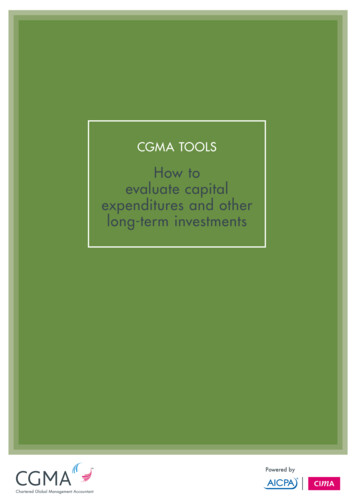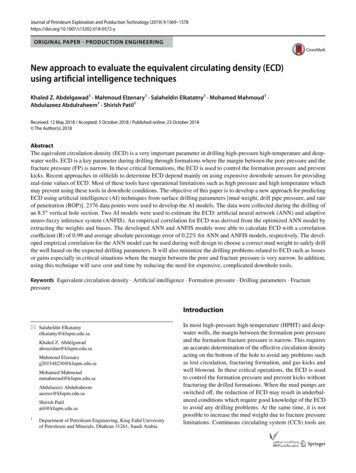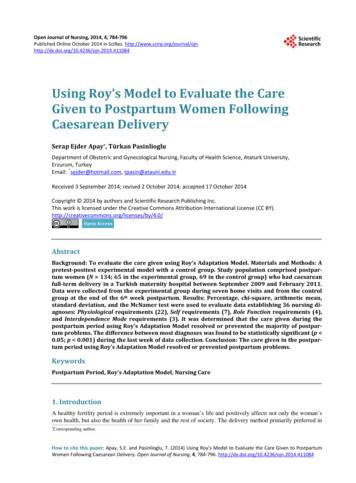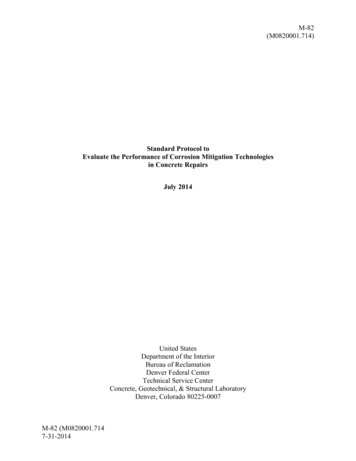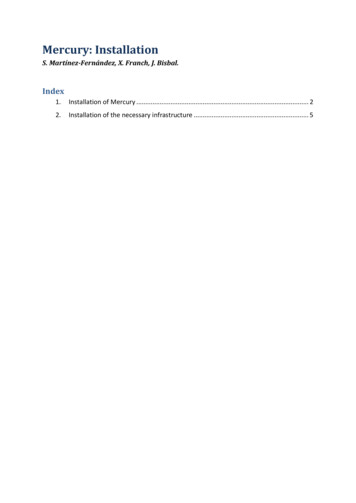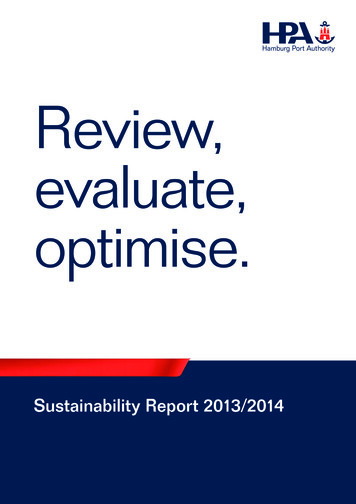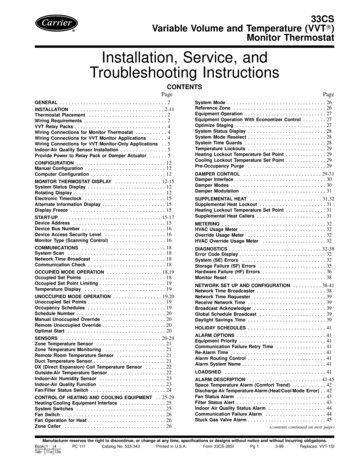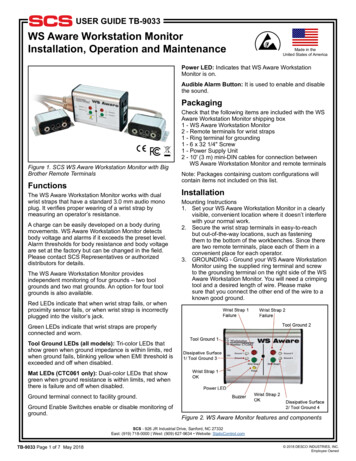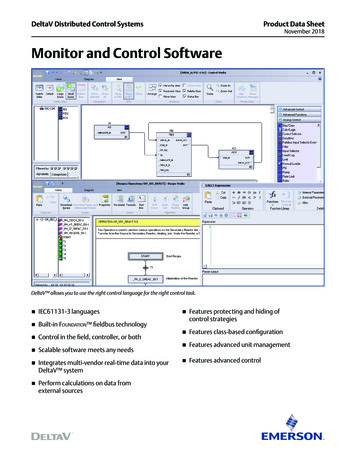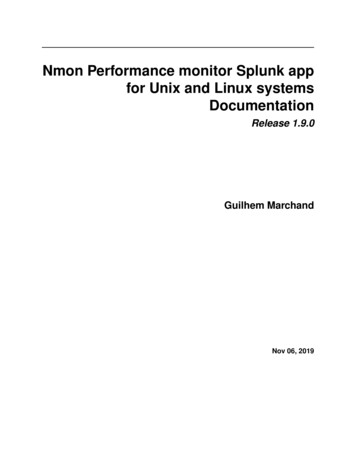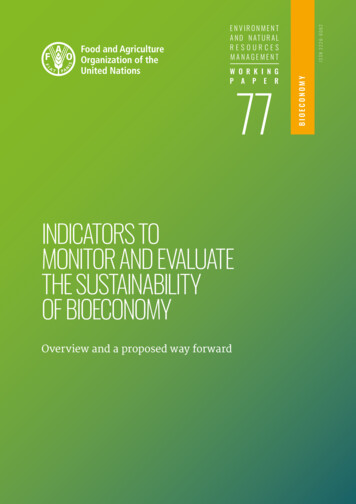
Transcription
77INDICATORS TOMONITOR AND EVALUATETHE SUSTAINABILITYOF BIOECONOMYOverview and a proposed way forwardBIOECONOMYW O R K I N GP A P E RISSN 2226-6062ENVIRONMENTA N D N AT U R A LRESOURCESMANAGEMENT
W O R K I N GP A P E R77INDICATORS TOMONITOR AND EVALUATETHE SUSTAINABILITYOF BIOECONOMYOverview and a proposed way forwardStefania Bracco, Almona Tani, Özgül Çalıcıoğlu, Marta Gomez San Juan and Anne BogdanskiFOOD AND AGRICULTURE ORGANIZATION OF THE UNITED NATIONSRome, 2019BIOECONOMYENVIRONMENTA ND N AT U R A LRESOURCESMANAGEMENT
Required citation:Bracco, S., Tani, A., Çalıcıoğlu, Ö., Gomez San Juan, M. & Bogdanski, A. 2019. Indicators to monitor and evaluate thesustainability of bioeconomy. Overview and a proposed way forward. Rome, FAO.The designations employed and the presentation of material in this information product do not imply the expressionof any opinion whatsoever on the part of the Food and Agriculture Organization of the United Nations (FAO)concerning the legal or development status of any country, territory, city or area or of its authorities, or concerningthe delimitation of its frontiers or boundaries. The mention of specific companies or products of manufacturers,whether or not these have been patented, does not imply that these have been endorsed or recommended by FAO inpreference to others of a similar nature that are not mentioned.The views expressed in this information product are those of the author(s) and do not necessarily reflect the views orpolicies of FAO.ISBN 978-92-5-131796-9 FAO, 2019Some rights reserved. This work is made available under the Creative Commons Attribution-NonCommercialShareAlike 3.0 IGO licence (CC BY-NC-SA 3.0 IGO; igo/legalcode/legalcode).Under the terms of this licence, this work may be copied, redistributed and adapted for non-commercial purposes,provided that the work is appropriately cited. In any use of this work, there should be no suggestion that FAOendorses any specific organization, products or services. The use of the FAO logo is not permitted. If the work isadapted, then it must be licensed under the same or equivalent Creative Commons licence. If a translation of thiswork is created, it must include the following disclaimer along with the required citation: “This translation was notcreated by the Food and Agriculture Organization of the United Nations (FAO). FAO is not responsible for the contentor accuracy of this translation. The original [Language] edition shall be the authoritative edition.”Disputes arising under the licence that cannot be settled amicably will be resolved by mediation and arbitration asdescribed in Article 8 of the licence except as otherwise provided herein. The applicable mediation rules will be themediation rules of the World Intellectual Property Organization http://www.wipo.int/amc/en/mediation/rules andany arbitration will be conducted in accordance with the Arbitration Rules of the United Nations Commission onInternational Trade Law (UNCITRAL).Third-party materials. Users wishing to reuse material from this work that is attributed to a third party, such astables, figures or images, are responsible for determining whether permission is needed for that reuse and forobtaining permission from the copyright holder. The risk of claims resulting from infringement of any third-partyowned component in the work rests solely with the user.Sales, rights and licensing. FAO information products are available on the FAO website (www.fao.org/publications)and can be purchased through publications-sales@fao.org. Requests for commercial use should be submittedvia: www.fao.org/contact-us/licence-request. Queries regarding rights and licensing should be submitted to:copyright@fao.org.
CONTENTSviAcknowledgements Abbreviations and acronyms viiExecutive Summary ix1.Introduction 11.1 Background and rationale 11.2 Study objective 22. Methodology and structure of the report 53. Definitions and indicator typologies 73.1 Sustainable bioeconomy principles, criteria and impact categories 73.2 Typology of indicators 103.3 Combining single indicators to report on indicator sets at territorial and product level 134. Review of indicators at territorial level 194.1 Review of monitoring approaches at territorial level 194.1.1 Specific national monitoring approaches for sustainable bioeconomy 4.1.2 Specific EU monitoring approaches for sustainable bioeconomy 4.1.3 Other approaches that are relevant for bioeconomy monitoring at territorial level 1921224.2 Identified indicators at territorial level 274.3 Data availability at territorial level 385. Review of indicators at product level 395.1 Review of monitoring approaches at product level 405.2 Identified indicators at product level 465.3 Data availability at product level 806. Discussion 816.1 Gaps/shortfalls in monitoring bioeconomy sustainability at territorial level 826.1.1 Sustainable consumption and production at territorial level: trade and related externality costs 6.2 Gaps/shortfalls in monitoring bioeconomy sustainability at product level 83886.2.1 Sustainable consumption and production of bioproducts: a circular approach 906.3 Ways to link the territorial and the product/value chain approaches 946.4 Good practices as indicators to monitor and evaluate bioeconomy sustainability 966.5 Trade-offs and synergies between impact categories 98iii
7.Conclusion and proposed way forward 1037.1 Stepwise approach to monitoring the bioeconomy Step 1: Stakeholder engagement Step 2: Choice of system boundaries 104106107Step 3: Identification of sustainability issues and relevant indicators 108Step 5: Discussion and selection of reference values for each indicator 112Step 4: Choice of indicators that reflect bioeconomy strategy objectives or hotspots Step 6: Definition of data collection methodology and assessment of data availability Step 7 (optional): Selection of good practices to address sustainability issues Step 8: Assessment of progress towards bioeconomy strategy objectives and sustainability goals Step 9: Effective communication of the results 1101121121131137.2 Limitations and way forward 117References 118Annex 1. Main characteristics and strengths of environmental, social andeconomic life cycle assessment 1251.125Life Cycle Assessment (LCA) 2. Social Life Cycle Assessment (S-LCA) 1263. Life Cycle Costing (LCC) 127iv
TABLES AND FIGURESTABLES1.2.3.4.5.6.7.Sustainable bioeconomy P&Cs and relatedimpact categories Strengths and weaknesses of reporting ongood practices Strengths and weaknesses of analyticalapproaches Strengths and weaknesses of life cycleimpact assessment frameworks 8.89.1210.1411.1712.Identified most suitable key indicators underthe bioeconomy objective in the LUKE approach 23Reviewed territorial monitoring approachesand their geographical scope Indicators for monitoring sustainability atterritorial level 13.Reviewed monitoring approaches at productlevel and their target sectors Indicators for monitoring sustainability atproduct/value chain level Indicators for trade sustainability Characteristics of existing tools to measureproduct circularity 44488592Example of indicator selection based on thesustainable bioeconomy P&Cs 108World ecological footprint and biocapacity(in global hectares), 1961-2016 87Examples of objective-specific indicators 1112628FIGURESES1. Stepwise approaches to indicator selectionsat territorial and product levels 1.2.3.4.Steps of the analysis Criteria for sustainable bioeconomy groupedby sustainability pillars The four phases of the life cycle assessmentframework Components of the Malaysia BioeconomyContribution Index (BCI) 5.Stages of the biomass value chain 7.Production vs consumption-orientedaccounting of resources 6.8.Product Sustainability Toolkit SDG indicators to achieve the sustainablemanagement and efficient use of naturalresources 9.xi10.611.812.1613.2114.404315.8486vCircular end-of-life options in the bioeconomy Example of the adoption of a good practiceas a proxy measurement Illustrative casual loop diagram of ecoagrifood system at the territorial level Stepwise approach to indicator selection atterritorial level Stepwise approach to indicator selection atproduct level 9097100106107Examples of spider diagrams at territorial level 114
ACKNOWLEDGEMENTSThis work was prepared by Stefania Bracco (Economist, Climate and Environment Division, CBC) andAlmona Tani (Consultant, CBC), under the supervision of Anne Bogdanski (Natural Resources Officer,CBC) and Olivier Dubois (Senior Natural Resources Officer, CBC), and with technical inputs from ÖzgülÇalıcıoğlu (Consultant, CBC) and Marta Gomez San Juan (Consultant, CBC).The authors are particularly grateful to: Andrea Camia (Bioeconomy project leader, EuropeanCommission, Joint Research Centre (JRC)), Jacopo Giutoli (Joint Research Centre, European Commission),Charlie Moosmann (Advisor, Deutsche Gesellschaft für Internationale Zusammenarbeit (GIZ) GmbH),Piergiuseppe Morone (Professor, Unitelma Sapienza - University of Roma), Sarah Mubareka (JointResearch Centre, European Commission), Órlaith Ní Choncubhair (Policy Officer, European Commission,DG Research & Innovation), and Danielle Alencar Parente Torres (Empresa Brasileira de PesquisaAgropecuária (Embrapa)) for their revisions and comments on the document.This report is one of the outputs of FAO project GCP/GLO/724/GER “Towards Sustainable BioeconomyGuidelines (SBG)” funded by the German Ministry for Food and Agriculture (BMEL).vi
ABBREVIATIONS ANDACRONYMSBCIBioeconomy Contribution Index (Malaysia)BERSTBioEconomy Regional Strategy ToolkitCAPcommon agricultural policyDEdomestic extractionDMCdomestic material consumptionECEuropean CommissionEMFEllen MacArthur FoundationEUEuropean UnionE-LCAEnvironmental Life Cycle AssessmentFAOFood and Agriculture Organization of the United NationsGDPGross Domestic ProductGEPGreen Economy ProgressGGKPGreen Growth Knowledge PlatformGhaglobal hectaresIINASInternational Institute for Sustainability Analysis and StrategyILOInternational Labour OrganizationISBWGInternational Sustainable Bioeconomy Working GroupISOInternational Organization for StandardizationJRCJoint Research CentreKPIsKey Performance IndicatorsLCALife Cycle AssessmentLCCLife Cycle CostingLCILife Cycle InventoryLCIALife Cycle Impact AssessmentMFmaterial footprintvii
MFAmaterial flow accountsM&Emonitoring and evaluationMPSMaritime Spatial PlanningMSMember StatesPAGEPartnership for Action on Green EconomyPEFProduct Environmental FootprintP&CsPrinciples and CriteriaRMCraw material consumptionRMEraw material equivalentsSCPsustainable consumption and productionSCLStandard, certificate and labelS-LCASocial Life Cycle AssessmentSDGSustainable Development GoalSETACSociety of Environmental Toxicology and ChemistrySOCsoil organic carbonTAASTracking Adaptation in Agricultural SectorsTEEBThe Economics of Ecosystems and BiodiversityTSCThe Sustainability ConsortiumUNEPUnited Nations Environment Programme (now UN Environment)WEFWater-Energy-Foodviii
EXECUTIVE SUMMARYXX indicators at the product/value chain level,FAO has been working for many years on non-foodbiomass products (including sustainable bioenergy)including indicators used for standards,and biotechnology, and it received a mandatecertificates, and labels (SCL).to coordinate international work on ‘food first’One of the objectives of this review is to avoidsustainable bioeconomy by 62 Ministers present atthe Global Forum for Food and Agriculture (GFFA)replication and build on indicators and data that2015. Moreover, FAO has received support from theare already available and countries/stakeholdersGovernment of Germany to develop guidelines onmay already report on.Important gaps and weaknesses emerge insustainable bioeconomy development (Phase 1:2016; Phase 2: 2017-mid 2020). This involves workthe reviewed literature with regard to social,on the bioeconomy monitoring, including theeconomic and environmental impact categoriesselection and use of indicators.of the bioeconomy, and associated dataavailability. First, the indicators identified inThe ultimate aim of FAO’s work onsustainability indicators is to provide technicalthe literature review, although quantitativelyassistance to countries and stakeholdersrelevant, are unequally distributed among thein developing and monitoring sustainablevarious principles and criteria. For instance,bioeconomy, more particularly on identifyingenvironmental sustainability criteria aresuitable indicators in line with the Sustainableaddressed the most, followed by social andBioeconomy Aspirational Principles andeconomic sustainability criteria.Secondly, this study introduces links betweenrelated Criteria, agreed upon in 2016 by theInternational Sustainable Bioeconomy Workingthe territorial and the product/value chain levels.Group created in the context of FAO’s projectOne key issue is how to clearly attribute theon Sustainable Bioeconomy Guidelines. Thesemeasurement of the indicators to the productionindicators shall help both policy makers andand use of biomass. This methodologicalproducers/manufacturers in monitoringchallenge is referred to as the “attributionand evaluating the sustainability of theirissue” and it is connected to both the attributionbioeconomy strategies and interventions.of statistical data to the bioeconomy and theattribution of general effects to the bioeconomy.In order to cover all the relevant aspectsAnother key issue identified by this studyand issues for a sustainable bioeconomy, ourapproach identifies impact categories fromis the availability and quality of data for thethe sustainable bioeconomy principles andindicators. In fact, data for many indicators arecriteria. The monitoring approach suggestedoften not collected on a regular basis and datais balanced, since it considers the threequality is a key problem for the estimation ofsustainability dimensions (social, economic andsome indicators. The study suggests the use ofenvironmental); at the same time, it proposes toproxy indicators as a complement to detaileduse a limited set of core indicators, to keep themeasurement. Good practices are introduced asmonitoring feasible and cost-effective.potential complementary indicators. Monitoringthe adoption of good practices and the qualityThe suggested methodology starts with areview of existing monitoring approaches toof their implementation can be useful toidentify already available indicators, from whichacknowledge and measure progress.This report also discusses trade-offs andthe authors compiled two comprehensive lists:synergies between the different sustainabilityXX indicators at the territorial level, whichissues. For instance, economic developmentincludes bioeconomy-relevant SDG indicators;ix
The recommended methodology is based oncould happen at the expense of inclusiveness(including the type of jobs created and the faira participatory approach: the choice of relevanttreatment of employees and working conditions)hotspots, priorities and indicators must occurand climate change mitigation.through stakeholder and expert engagement.The methodology also allows for some flexibilityFinally, the study identifies solutions anda possible way forward to help countries andto reflect circumstances and specific needs ofpractitioners in their monitoring and evaluationthe stakeholders. It also facilitates the inclusionefforts: a stepwise approach to monitoringof new indicators in order to improve thethe bioeconomy sustainability, includingmonitoring approach over time, and to adaptthe selection of relevant indicators, both atindicators as the sector and/or policy needsterritorial and product levels (Figure ES1).evolve over time.x
F I G U R E E S 1.STEPWISE APPROACHES TO INDICATOR SELECTIONS AT TERRITORIAL AND PRODUCT LEVELSTERRITORIAL LEVELPRODUCT LEVELSTEP 1STAKEHOLDER ENGAGEMENTSTEP 1STAKEHOLDER ENGAGEMENTSTEP 2CHOICE OF RELEVANT TERRITORIALLEVEL (GLOBAL, REGIONAL, NATIONALAND SUB-NATIONAL LEVELS)STEP 2CHOICE OF KEY PRODUCTS/VALUE CHAINSSTEP 3SELECTION OF RELEVANT INDICATORSTO ENSURE ADEQUATE COVERAGE OFSUSTAINABILITY ISSUESSTEP 3IDENTIFICATION OF HOTSPOTS ANDTHEIR SUSTAINABILITY ISSUESCHOICE OF A SET OF INDICATORS THATREFLECT THE PERFORMANCE/PROGRESS OFTHE BIOECONOMY STRATEGY OBJECTIVESSTEP 4SELECTION OF RELEVANT INDICATORS TO ENSUREADEQUATE COVERAGE OF SUSTAINABILITY ISSUESFOR EACH IDENTIFIED HOTSPOTSTEP 5DISCUSSION AND SELECTION OFREFERENCE VALUES FOR EACH INDICATORSTEP 5DISCUSSION AND SELECTION OF REFERENCEVALUES FOR EACH INDICATORSTEP 6DEFINITION OF DATA COLLECTIONMETHODOLOGY AND ASSESSMENT OFDATA AVAILABILITYSTEP 6DEFINITION OF DATA COLLECTIONMETHODOLOGY AND ASSESSMENT OFDATA AVAILABILITYSTEP 4(OPTIONAL)STEP 7(OPTIONAL)STEP 7SELECTION OF GOOD PRACTICES TOADDRESS SUSTAINABILITY ISSUES(OPTIONAL)SELECTION OF GOOD PRACTICES TO ADDRESSTHE HOTSPOTS AND SUSTAINABILITY ISSUESSTEP 8ASSESSMENT OF PROGRESS TOWARDSBIOECONOMY STRATEGY OBJECTIVESAND SUSTAINABILITY GOALSSTEP 8ASSESSMENT OF THE SUSTAINABILITY OF THEVALUE CHAIN AND ITS CONTRIBUTION TOBIOECONOMY STRATEGY OBJECTIVESSTEP 9EFFECTIVE COMMUNICATIONOF THE RESULTSSTEP 9EFFECTIVE COMMUNICATIONOF THE RESULTSxi
C H A P T E R1INTRODUCTION1.1BACKGROUNDAND RATIONALEto measure, one needs to know where themeasurement shall start and where it shall end.Some sources depict the bioeconomy as a newdevelopment path, an alternate model to thecurrent (petrol-based) economy. The bioeconomyis seen as a “master narrative” to tackle andovercome the limits of the current economicsystem. Biomass or biological resources are atThe concept of the bioeconomy aims to addressthe heart of the discourse. Shifting from the useseveral global challenges such as climate change,of fossil fuel resources to the use of biologicalfood security, health, and energy security in aresources in the production and use of materialscoherent way. At the same time, the bioeconomysuch as plastics, textiles and chemicals is seen asis seen as an engine for innovation, fuelled bya way to make our daily lives “greener”, “fairer”new research and development in the biologicaland “more inclusive”. In a nutshell, this newand engineering sciences. However, despite thesedevelopment path is thought to lead to a moregrand claims, there does not seem to be onesustainable paradigm. Its boundaries are widecommon understanding of what the bioeconomyand open. In this narrative, the bioeconomy isactually means. What does it entail, where are itssought to be a new economic model – at local,boundaries? When discussing monitoring andnational, regional or global scale. The focus forevaluation (M&E) with regards to the impact ofM&E is the contribution of the bioeconomy tobioeconomy development, these are importanteconomic development, and its (positive andquestions to ask, because before one can startnegative) impacts on nature and society.1
INDICATORS TO MONITOR AND EVALUATE THE SUSTAINABILITY OF BIOECONOMYbased on the assumption that the bioeconomyOther sources look at the bioeconomy from ais a new development path. In this case,production angle. At the centre of the discourseindicators seek to measure the contributionis the bioproduct, not the economy as a whole.of the bioeconomy to the overall economy andRather than a new development path, this schoolwellbeing. This study considers four territorialof thought sees the potential of the biological andlevels: global level, regional level (macro-engineering sciences (among others) to replaceregions, such as the EU), national level,selected fossil resource-driven processes andsub-national level. For simplicity, the resultsproducts with the variety of bio-technologiesof these four levels are often shown togetherand innovations provided by research andunder the label “territorial”.development. The development of a bioeconomy2 A second approach on the use of productat product level represents improvementlevel/value chain indicators
The monitoring approach suggested is balanced, since it considers the three sustainability dimensions (social, economic and environmental); at the same time, it proposes to use a limited set of core indicators, to keep the monitoring feasible and cost-effective. The suggested methodology starts with a review of existing monitoring approaches to
